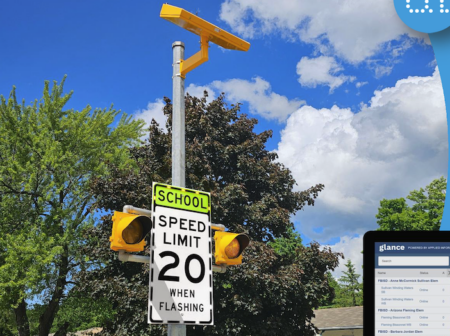German automotive technology supplier Continental is introducing its new Intelligent Intersection technology, with the system due to be rolled out in a real-world smart city pilot in Ohio next year.
According to the US Department of Transportation (USDOT), 51% of all injury crashes and 28% of all fatal crashes in the USA occur at intersections. Continental is aiming to reduce those statistics with its combination of advanced driver assistance, vehicle-to-everything (V2X) communications, and sensor technologies, in order to create safer, more intelligent road junctions.
The technology detects road users within a 360° perimeter of intersections and communicates the position and movement of these objects to all approaching vehicles that are equipped with V2X technology. Continental’s Intelligent Intersection concept is an end-to-end system, comprising the complete sensor set for an intersection, the powerful sensor fusion algorithms that generate the environment model, and the dedicated short-range communication (DSRC) units, both at the intersection, and in vehicles.
Sensors, such as cameras, radar and lidar units, are positioned at the corners of an intersection and detect every road user in the area and deliver a list of relevant objects to a sensor fusion unit, which generates a comprehensive 360° environmental model. Relevant objects are then broadcasted via DSRC to every vehicle approaching the intersection. A DSRC control unit in the vehicle receives the messages, then an onboard system checks it for relevance, and triggers an appropriate action if a critical situation is recognized.
Continental will also make use of all-round traffic information gathered at the intersection and upload the data into its backend, where it will be analyzed to provide a better understanding of traffic flow and congestion.
The Intelligent Intersection technology was first demonstrated on a test track in October at Continental’s development center in Brimley, Michigan (MI). The next steps include a broader test roll-out and pilot implementation of the technology at an intersection in the City of Columbus, which was the winner of the USDOT’s 2016 Smart City Challenge competition.
“We are proud to contribute our Intelligent Intersections technology to a highly innovative city like Columbus,” said Jeremy McClain, head of systems and technology at Continental North America.
“Our solution is based on transferring and adapting vehicle-proven hardware and software solutions to an infrastructure application. Cities will be able to deploy this technology to increase safety for their citizens and visitors alike. In the longer term, the technology can also serve to improve inner-city traffic flow, thereby reducing travel time and vehicle emissions.”




